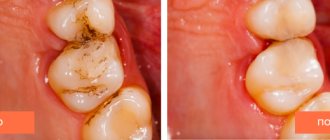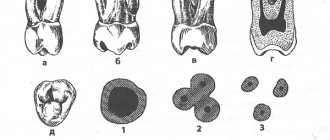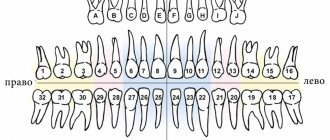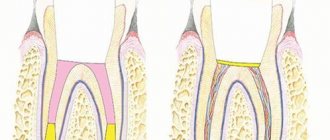Author of the article:
Soldatova Lyudmila Nikolaevna
Candidate of Medical Sciences, Professor of the Department of Clinical Dentistry of the St. Petersburg Medical and Social Institute, Chief Physician of the Alfa-Dent Dental Clinic, St. Petersburg
Before talking about the treatment of pulpitis with unformed roots, you need to understand what unformed roots are.
After the eruption of baby teeth, their roots have an uncovered apex for several years, which is why they are called unformed.
Features of the treatment of pulpitis on teeth with unformed roots
Treatment of pulpitis on such teeth has its own characteristics. Due to the fact that it is impossible to completely treat the entire length of the tooth roots and extract the pulp, traditional devital and vital methods for treating teeth with immature roots are not suitable. Therefore, pediatric dentists use biological treatment methods or the amputation method.
Conservative treatment
It should be noted that biological (conservative) treatment is a rather complex process that has a number of contraindications. The main principle of treatment is maintaining absolute sterility. It is very important to carry out high-quality antiseptic and aseptic processing.
During the biological treatment of pulpitis, the dentist, under anesthesia, removes not only plaque, but also all affected and dead dental tissue, prepares the tooth cavity and applies medicine to the exposed nerve (or to the bottom of the carious cavity). As a rule, this medicinal paste contains calcium hydroxide. After all pain symptoms disappear after a few days, a permanent filling can be installed. The main thing is that as a result of this treatment, the tooth retains its vitality and strength, and the pulp provides nutrients to its tissue.
Amputation method for treating teeth with immature roots
Due to the complexity of biological treatment and the existing contraindications to this method, this method is used infrequently by dentists. And most doctors prefer amputation, during which the doctor removes the infected pulp from the pulp chamber using a vital or non-vital method.
- The devital method using arsenic compounds is not used in every clinic today. Some dental offices use phenol-formalin to necrotize the pulp. To do this, a swab moistened with this solution is applied to the tooth cavity for 4-5 days.
- Most often, pediatric dentists treat pulpitis using the vital method, without the use of arsenic. To do this, doctors use not only local anesthesia, but also various antibacterial drugs, calcium-containing drugs and remineralizing agents. During this method, the pediatric dentist, after taking care of anesthesia, excises the upper part of the pulp and applies a special preparation. Thanks to this method, it is possible to preserve the root pulp, which means that in the future the dental roots will continue their normal formation.
Alternative
Prevention of pulpitis is careful adherence to hygiene rules. Use Asepta toothpastes, which effectively strengthen tooth enamel and prevent the growth of bacteria in the oral cavity.
Principles of treatment of teeth with formed roots
The tactics for treating chronic periodontitis are identical to the approach for treating temporary teeth. If the following conditions are met, it is possible to cope with the disease in one visit:
- there is no gangrenous decay with a putrid odor in the canal;
- there are no granulations grown into the canal;
- there was no exacerbation of such diseases in the anamnesis;
- it is possible to qualitatively process the canal in one visit and dry it;
- the child is somatically healthy and does not take antibiotics, cytostatics, corticosteroids or other immunosuppressive drugs.
In this case, during one visit, the root canal is treated instrumentally and medicinally, obturation is performed with a permanent root filling, and then the crown part is restored. It is much more common to practice treatment in several stages.
On the first visit, the following manipulations are performed:
- necrotomy, formation of a carious cavity;
- opening the canal and removing putride masses from it using a pulp extractor or several - with a very wide canal;
- removal of granulations grown into the canal with injection anesthesia or short-term treatment of granulations with special preparations, for example camphorophenol (very carefully so as not to burn the mucous membrane);
- instrumental treatment of the canal, washing and drying;
- administration of a medication with an antiseptic effect on the turunda or in the form of a paste;
- isolation with an airtight bandage for temporary obturation of the carious cavity.
The medicine is left on average for 1-7 days, after which permanent obturation is performed - subject to the conditions of readiness of the root canal. Obturation is carried out with a sealer with gutta-percha, after which X-ray control is necessary, and only then restoration of the crown.
Clinical researches
“Results of clinical use of the Asepta series of products: already at the first control examination (after 1-2 days) of using the Asepta line of products, there is a decrease in complaints of discomfort, but bleeding persists when brushing teeth. On the 7th day, complaints of gum bleeding persisted in 4 patients. Upon examination, a decrease in hyperemia and swelling of the gums was noted, but bleeding persisted upon probing. After the final application of the gel with propolis, normalization of clinical manifestations was revealed, which is manifested by the absence of bleeding during brushing and probing.”
Sources:
- The effectiveness of the use of Asept “adhesive balm” and Asept “gel with propolis” in the treatment of chronic generalized periodontitis and gingivitis in the acute stage (Municipal Dental Clinic No. 4, Bryansk, Kaminskaya T. M. Head of the therapeutic department Kaminskaya Tatyana Mikhailovna MUZ City Dental Clinic No. 4, Bryansk
- Study of the clinical effectiveness of treatment and prophylactic agents of the Asepta line in the treatment of inflammatory periodontal diseases (A.I. Grudyanov, I.Yu. Aleksandrovskaya, V.Yu. Korzunina) A.I. GRUDYANOV, Doctor of Medical Sciences, Prof., Head of Department I.Yu. ALEXANDROVSKAYA, Ph.D. V.Yu. KORZUNINA, asp. Department of Periodontology, Central Research Institute of Dentistry and Maxillofacial Surgery, Rosmedtekhnologii, Moscow
- The role of anti-inflammatory rinse in the treatment of periodontal diseases (L.Yu. Orekhova, A.A. Leontyev, S.B. Ulitovsky) L.Yu. OREKHOVA, Doctor of Medical Sciences, Prof., Head of Department; A.A. LEONTIEV, dentist; S.B. ULITOVSKY, Doctor of Medical Sciences, Prof. Department of Therapeutic Dentistry of St. Petersburg State Medical University named after. acad. I. P. Pavlova
- Report on the determination/confirmation of the preventive properties of personal oral hygiene products “ASEPTA PLUS” Remineralization doctor-researcher A.A. Leontyev, head Department of Preventive Dentistry, Doctor of Medical Sciences, Professor S.B. Ulitovsky First St. Petersburg State Medical University named after. acad. I.P. Pavlova, Department of Preventive Dentistry
- Clinical studies of antisensitive toothpaste “Asepta Sensitive” (A.A. Leontyev, O.V. Kalinina, S.B. Ulitovsky) A.A. LEONTIEV, dentist O.V. KALININA, dentist S.B. ULITOVSKY, Doctor of Medical Sciences, Prof. Department of Therapeutic Dentistry, St. Petersburg State Medical University named after. acad. I.P. Pavlova
Treatment of periodontitis for children Medvedkovo, Babushkinskaya
Types of periodontitis
This disease has several varieties, it all depends on the stage and location of the source of infection.
Depending on the location, periodontitis can be apical or marginal. Apical – consequences of untreated pulpitis. Regional – consequences of injury. Periodontitis has two main stages: acute and chronic. In the first case, the patient experiences pain when pressing on the infected area, and swelling occurs in the same place. At this stage, the disease can be cured quickly and effectively. If this is not addressed, periodontitis becomes chronic. The tooth begins to loosen and the temperature rises.
Acute periodontitis is also divided into two subtypes.
- Serous
- Purulent
With serous periodontitis, the tooth does not become loose, the pain may appear quickly, but also pass quickly, and it is not so severe. When purulent, the unpleasant and painful sensations intensify; pus accumulates in the gum, after which it breaks through and comes out. In this case, the tooth is already beginning to become loose; if treatment is not started immediately, the tooth will have to be removed.
Chronic periodontitis also has various forms, there are three in total.
- Fibrous
- Granulating
- Granulomatous
The first is the lightest and almost invisible. The child may experience some pain. An x-ray will be required for diagnosis. The granulating form is the most common. With it, the patient experiences constant pain, the gums swell, and purulent discharge is observed.
The granulomatous form is the most dangerous and occurs in cases of advanced disease. In this case, the inflamed tooth tissues become granulomas - cavities filled with pus. If they burst, blood poisoning is possible; medication cannot get rid of them; they must be removed urgently.
Treatment of acute periodontitis in children
Effective and high-quality relief from this disease requires several visits to the dental clinic. To begin with, the doctor expands the dental canals, cleans them, rids the tooth of all affected tissue, and treats it with antiseptic and disinfectants.
The cleaned cavity is closed with a special bandage, which allows pus and other secretions to escape. The patient is treated with antibiotics for several days. During the second visit, the dentist checks the canals, cleans them again and places a temporary filling. Additionally, magnetic or laser therapy may be prescribed.
Drug treatment lasts for a long time. After this, a control X-ray is taken and the doctor decides whether the disease is cured or not. If so, the cavity is thoroughly cleaned again and a permanent filling is placed.
Treatment of chronic periodontitis in children
The chronic form of this disease can be successfully treated, but it will take longer. If periodontitis is fibrous, there is no need to expand the canals; everything is done faster. The other two forms provide for the installation of a temporary filling, which will have to be worn for up to three months. In particularly difficult cases – up to six months. This is the time frame required for effective treatment.
And only in a very advanced form, when it comes to a threat to the patient’s life, does the dentist decide to remove the tooth. In addition, if all the doctor’s requirements are not followed, treatment may be ineffective, and relapse of the disease is possible. But a tooth is removed in extreme cases, if you monitor the condition of the oral cavity, it doesn’t come to that.
Details and nuances of treatment of periodontitis in children
Modern dentistry has many methods for treating periodontitis in children. You just have to take into account that in most cases this process will take a long time. But timely treatment allows you to save your teeth. This is especially important for the development of correct occlusion in childhood.
You can almost completely minimize the risk of this dangerous disease if you visit a dental clinic; it is best for children to do this once every 3-4 months. This will allow specialists to notice signs of the disease in time, prescribe treatment and successfully get rid of problems.
Conservative methods
At the slightest opportunity to save the tooth, gentle conservative treatment is used. Endodontic treatment involves repeated root canal treatment.
First visit
- Anesthesia.
- Cleaning out the carious cavity with a drill, removing softened dentin (bone dental tissue).
- Expansion of the root canal mouth using a special hand instrument.
- Removal of the “dead” pulp – the neurovascular bundle inside the cavity.
- Expansion of the canal and its mechanical cleaning.
- Rinsing the cavity with an antiseptic solution - sodium hypochlorite or chlorhexidine bigluconate.
- Opened apical (root) openings for the outflow of exudate.
- Filling the canal with an anti-inflammatory drug: for permanent teeth - a paste based on calcium hydroxide, for temporary teeth - an oil-based paste.
The doctor leaves the tooth in this state for some time - from 2 to 10 days. In the intermediate period, rinsing the mouth with antiseptic solutions (Chlorhexidine, Miramistin) is prescribed, and less often, taking antibiotics.
Treatment of a tooth with dead pulp
Second visit
- Mechanical cleaning of the canal, removal of medication.
- Washing with an antiseptic.
- Installation of a permanent filling - hermetically closing the cavity with gutta-percha, hydroxyapol or other material.
Physiotherapy
Physiotherapeutic methods are used as an aid in the fight against inflammation. These are inexpensive and painless procedures, children tolerate them well:
- electrophoresis of antiseptics - enhancing the antiseptic effect using pulsed current;
- phonophoresis – introduction of an antiseptic under the influence of ultrasound;
- laser therapy – the laser beam sterilizes the root canals and has a direct bactericidal effect.
Laser therapy
Root canal treatment
What is endodontics?
The term "endodontics" comes from two words: "endo" means
“inside”, and “odont” - “tooth”.
Endodontics is
one of the areas
in
therapeutic
dentistry
and involves the treatment of complicated caries. During endodontic intervention, depulpation (removal of the nerve from the tooth canal), cleaning and hermetically sealing of the root canal are performed. You have to resort to this treatment:
- when a previously healed carious process gave complications: pulpitis , periodontitis,
granuloma, cyst
. - in case of tooth trauma
- medical errors made during treatment.
Also, an orthopedic dentist can refer a patient to an endodontist. In some cases, before installing a crown or prosthesis, it is advisable to depulp the tooth. This eliminates discomfort after installation of the orthopedic structure. IMPORTANT:
Endodontic treatment is a whole complex
of treatment of the tooth canals
of successive stages of treatment aimed at preserving the tooth.
Stages of prosthetic treatment.
Many people are painfully familiar with the situation when a “dead” tooth suddenly begins to bother you: swelling appears and it hurts to bite. For a person tormented by pain and insomnia, the doctor’s words: “The tooth must be removed! - sound like a sentence, because after the pain goes away, other problems begin - implantation
and prosthetics.
But nowadays it’s not cheap. The main goal of endodontic treatment of tooth canals is
: effective cleaning of the root canal system and microtubules (sterilization), relieving inflammation and preserving the tooth.
STEPS:
- depulpation or unfilling of a previously treated canal
- mechanical expansion (correct formation of the main channel)
- disinfection and medicinal treatment
- canal sterilization
- hermetic obturation (sealing).
IMPORTANT:
Thus, the global goal of endodontic treatment will be achieved - ensuring the integrity of the body by restoring tissue barriers and preserving the tooth.
What do modern endodontists use?
The root of a tooth is a whole system of branched canals that penetrate the entire
tooth root. They connect to the main canal and form a complex network of tubules through which our tooth is supplied with food and innervation. And even the most experienced dentist is physically unable to clean and seal this complex network of canals and tubules. The infection remains in them and waits in the wings. Therefore, the most modern techniques help ensure the absence of complications in the future:
- microscope or binoculars (imaging equipment)
- nickel titanium instruments
- endomotors with built-in apex locator
- ultrasonic treatment
- diode laser
; - various protocols for medicinal treatment of canals.
Important:
Only the latest technologies, the best tools and materials can provide high and stable treatment results. Therefore, modern endodontics deserves special attention.
Why are channels so important? Why is it necessary to treat dental canals?
The root of a tooth is a system of branched channels through which useful substances flow and innervation of the tooth is ensured. Damage to the tissues that form these canals and the lack of timely and high-quality treatment will certainly lead to tooth loss. At the same time, the complexity of root canal treatment is evidenced by the fact that the number of roots in a tooth varies, they can have bends and branches.
To carry out endodontic therapy at the highest level, it is necessary to combine high professionalism of specialists, excellent equipment of the dental center, and the use of only high-quality materials.
The Dentist clinic fully complies with all these conditions. IMPORTANT:
To provide high-quality endodontic therapy, it is necessary to have an idea of how many roots the teeth have and what the bends of these roots are.
Materials for canal filling.
The main task that a specialist faces after completing the mechanical and
medicinal treatment of the canal - hermetically seal it. The best result is achieved:
- using the lateral condensation method, which involves the use of gutta-percha pins compacted and fastened together with a cementing substance;
- using the Thermafil system. In this case, gutta-percha heated to 200 degrees under pressure is injected into the canal, which allows you to thoroughly fill all branches and achieve perfect tightness.
- using high-quality antiseptic pastes and cements.
The specialists of the Dentist clinic, striving to perform canal filling with the highest quality possible, use precisely these, the most modern, techniques in their work.
IMPORTANT:
The essence of any canal filling is that the substance introduced after removal of the nerve, mechanical and medicinal treatment of the canal must completely clog the canal to prevent the development of infection in the canal.
Why is mechanical treatment of the canal necessary?
In addition to canal sealing, an equally important part of endodontic treatment is mechanical
canal treatment and sterilization. Experts believe that the persistence of tooth pain after completion of all therapeutic measures, the development of a granuloma or cyst at the apex of the tooth root is due precisely to insufficiently effective actions at this stage. To eliminate the need for tooth extraction due to poor quality treatment, you should entrust the procedure to professionals.
IMPORTANT:
In pursuit of a lower price, during endodontic treatment, patients forget a simple rule: “He who is treated for nothing, is treated for nothing!”
And as a result of this approach, removal followed by implantation
! Although high-quality endodontic treatment would cost much less! But this thought comes to me, it’s too late!
What tools are used?
Treatment of canals is complicated by the fact that narrow convoluted tubules are difficult to treat with medication, and there are difficulties with filling them. Modern clinics, such as Dentist, have the necessary equipment to effectively and efficiently carry out this volume of work. With the use of a multi-functional endodontic handpiece and nickel-titanium instruments, the process has been greatly simplified. Thanks to their sufficient hardness and elasticity, it is possible not only to expand, but also to straighten the tortuous channels. IMPORTANT:
With the advent of the multifunctional endodontic handpiece and
Nickel-titanium instruments, impassable and narrow channels are a thing of the past!
Specialists at the Dentist clinic widely use Japanese endomotors with a built-in apex locator.
With its help, it is possible to achieve unique precision in canal treatment. At the same time, careful execution of all manipulations is guaranteed by triggering the auto-reverse. The presence of a liquid crystal display makes it possible to receive all the necessary information about the channel and fully control the progress of treatment. Endoscopic root canal treatment
is another technology that is used both as a preoperative examination and for active endodontic treatment. With the advent of the endoscope, it is possible to achieve more meaningful monitoring of the working field than with the help of micromirrors and microprobes.
IMPORTANT:
No amount of equipment, even the best, can replace the good hands of a doctor. But such equipment helps the doctor do his job efficiently and with maximum benefit for the patient.
What methods are used?
To carry out endodontic treatment, two methods of instrumentation of canals are used. The Step-back technique is a classic option. It involves expanding the canal, starting from the apex, by using instruments from smaller to larger sizes. Root canal treatment from top to bottom, using the Crown Down technique, is a more progressive and safer technique that provides better access to the apex. In this case, the expansion of the root canal proceeds from the mouth to the apex using instruments from larger to smaller sizes. However, to use this technique you need modern equipment, an endomotor. Using this innovative toolkit, the specialists of the Dentist clinic are ready to carry out the entire course of endodontic treatment at a completely new level, ensure a high-quality result, and completely eliminate the development of complications.
Disinfection and sterilization of the canal.
The most modern methods of disinfection and sterilization of tooth canals are international medicinal protocols for canal treatment, the use of a diode laser and the Depophoresis technique.
Laser exposure
provides a bactericidal, anti-inflammatory, immunostimulating effect.
Conducted Depophoresis
, based on the disinfecting properties of copper-calcium hydroxide in an electric field, promotes the restoration of destroyed bone tissue, protects the tooth root from the action of an infectious pathogen.
Cost of root canal treatment.
In general, such a concept as “impenetrable” root canals is a purely
domestic, which 10-15 years ago was caused by the lack of necessary tools and materials. Unfortunately, endodontics of our time has been divided into two, almost independent layers! It's no secret that the cost of root canal treatment in Moscow
in different clinics varies greatly!
Price for root canal treatment
depends on several factors:
- First of all, is the tooth single-rooted or multi-rooted?
- on the quality of the material
- on the tools and technologies used
- from the qualification of a dentist.
One category of clinics
focuses on the budgetary provision of endodontic services, which includes manual expansion of root canals, their subsequent filling and, as a final step, a targeted radiograph for quality control. The technical capabilities of such dentistry do not allow endodontic treatment of teeth taking into account all the complexities of the internal structure of root canals. Some channels remain unfound or untraversed along their entire length.
Other category of clinics
— modern, knowledge-intensive endodontics! It requires the highest technology and the same qualifications from all personnel. The complexity of this treatment lies in the fact that the internal volume of the tooth can be extremely small; the lumen of the root canals is often so narrow that it is difficult to even detect it. It requires the dentist to have enormous experience and intuition, mastery of a variety of high-tech diagnostic and treatment methods. This is a special high-quality toolkit. But the most important thing is the doctor himself. And the fate of your teeth depends on his ability to apply all the variety of modern treatment methods!
Important:
Endodontists, who have access to the latest technological innovations, spend a lot of time, effort and expensive materials on root canal treatment!
Treatment of root canals near Chistye Prudy metro station.
Treatment of tooth root canals
is a painstaking and delicate work.
Treatment of tooth canals near the metro
Chistye Prudy
is carried out by experienced, competent doctors. Dentist therapists will carry out the entire necessary range of therapeutic and diagnostic measures. The Dentist clinic is equipped with a radiovisiograph and orthopantomograph; in the process of root canal treatment, modern endomotors-apex locators, binoculars and other equipment necessary for thorough diagnosis and treatment are used.
Our advantages:
- We are located in the center of Moscow.
- We attract highly qualified specialists to work.
- We adhere to an honest and transparent pricing policy.
- Positive reviews about our clinic prevail.
- A thorough study of the area of intended intervention will help you build the right treatment plan and avoid complications!
We invite you to undergo endodontic treatment at the Dentist clinic near the Chistye Prudy metro station. Root canal treatment is carried out without pain and stress. Even if you come to the clinic with acute pain, the doctor immediately takes measures to relieve it. We work according to a schedule convenient for patients and accept appointments by appointment.










